About Karatara Pass
Karatara is the fifth of the seven passes on what is known as the 7 Passes Road. Back when it was constructed in the 1880s this route involving seven passes was the only route between George and Knysna. It was to remain so for almost 70 years before the N2 through Wilderness replaced it with a faster option.
Did you know? Today the route of seven passes is one of numerous back roads that make driving this part of the country so delightful.
Karatara Pass is close to the Knysna end of the route, after the Phantom and Homtini passes (if driving from Knysna). The pass starts close to the little village of Karatara. Both it and the pass are named after the Karatara River up in the mountains, almost directly north of Sedgefield's Groenvlei Lake.
At Karatara is Tsiba College, Africa's first rural enterprise campus, where every student (from marginalised communities) receives two full scholarships – one for board and lodging and another for education, which focuses on both personal development and environmental sustainability.
At least three alternative routes lead from the 7 Passes Road down to Sedgefield.
This portion of the route was designed and implemented by Thomas Bain. The George end of the route was built by his brother-in-law Adam de Smidt. The experience was to evidently cause a rift between the two.
Karatara Pass is a short pass of under 3 km, but it drops 90 metres in altitude to the Karatara River valley, crossing the river at a concrete bridge similar to that on the Hoogekraal pass allowing two lanes of traffic.
Once over the bridge, the climb out of the valley is of the steepest of all the passes on the route and includes a notable sharp hairpin bend. The short pass comes to an end at the village of Barrington, where the road is tarred for a couple of kilometres.
Before driving the pass be aware that because it is gravel it can be pot-holed, corrugated and water-logged, depending on the weather.
Need to Know
WhereKaratara Pass, Between George and Knysna, Garden Route, Western Cape, South Africa
WhenBest during daylight hours.
OvernightStay in Knysna Accommodation, Garden Route
Disclaimer
Please note, business details can change. While we endeavour to ensure all information provided by the service provider is correct at the time of publication, we do not assume any liability caused by errors or changes, such as price, cost, time, and location. Please check with the provider that the activity/business is still offered as described, before making any travel plans.
Feedback?
If this is your attraction, you can let us know if anything on this page is outdated or contains inaccuracies, by email. We regret, we do not have any other information, please contact the provider if you have questions.
Additional Reading
You might also be interested inAttractions near Knysna
In the vicinity
Hotels & other accommodation options in Knysna
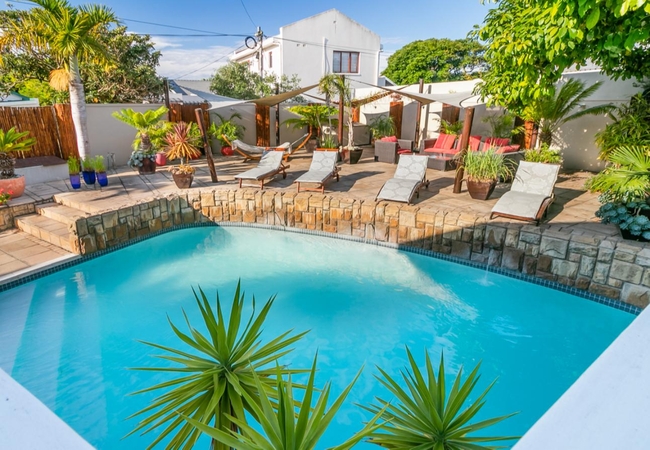
African Breeze Guesthouse
At African Breeze Guest House we invite you to explore the beauty of this exclusive island in contemporary accommodation and beautiful surroundin...

Hide-Away Guest House
If you are passing through Knysna and intend only staying one night, or have Knysna as a specific destination in mind to stay for a couple of day...

Lakeside Accommodation
Located in Knysna, Lakeside offers self catering accommodation in beautiful wooden rooms which have en-suite bathrooms, TV, M-Net and self-cateri...

Dazzling View
Dazzling View is a luxury self catering holiday home offering accommodation in Knysna. The spacious villa is perched high above Knysna lagoon com...
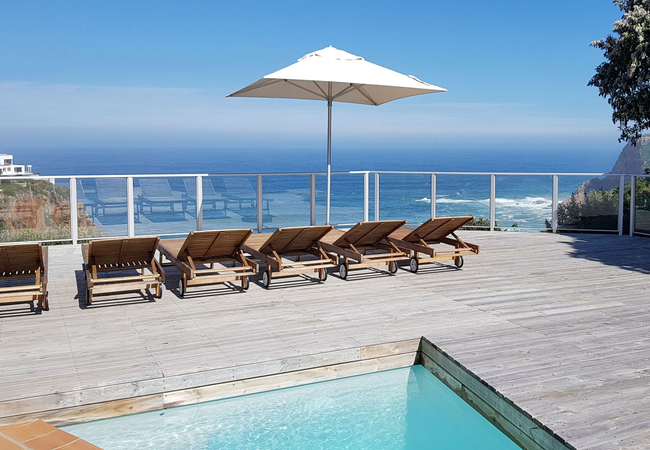
Headlands House Guest Lodge
Headlands House boasts dramatic sea, lagoon and cliff views from every window. Uniquely situated on the highest point of the famous Knysna Heads,...
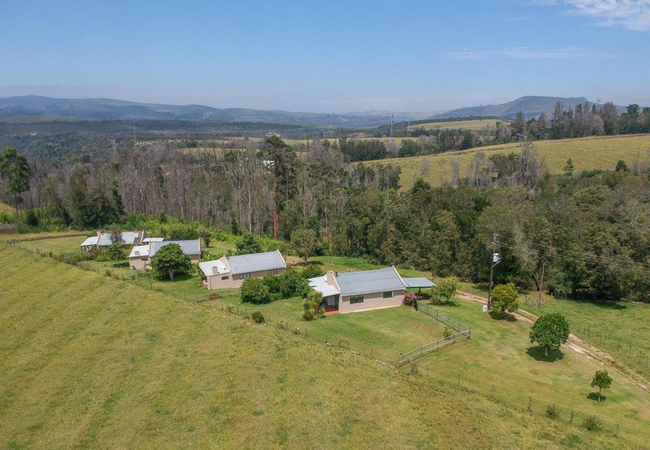
Fernhill Guest Farm
Fernhill Guest Farm is situated in the Rheenendal area just outside Knysna. Enshrouded in lush indigenous forest and surrounding a scenic lagoon ...
Beacon House Apartment One
Beacon House Apartment One offers luxury self-catering accommodation in Knysna. Beacon House is one of the most perfectly located properties in t...

Bamboo, The Guesthouse
Nestled in a truly magnificant indigineous garden with a sparkling saltwater pool, are 5 individualised and elegantly furnished cottage rooms wit...
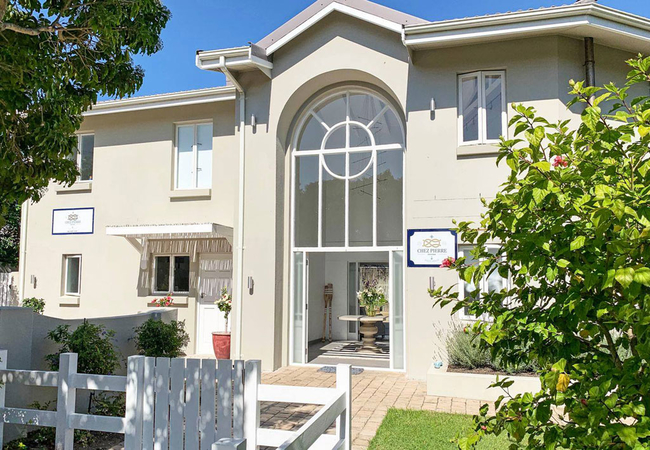
Chez Pierre
Located in Knysna, Chez Pierre offers accommodation in a double story guesthouse which has five en-suite rooms. The establishment has a lovely co...

Resort Living on the Water
Resort Living on the Water, located in the prestigious Thesen Islands Estate and Marina, offers a luxurious self-catering holiday accommodation. ...
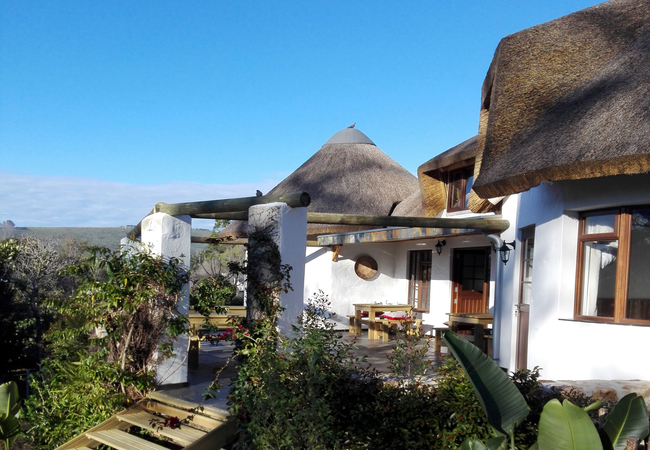
Badger's Lodge
Badger's Lodge is situated close to the Knysna Lagoon and about 3 km out of Knysna's enchanting town centre and the picturesque waterfront. We of...

Guesthouse The Lazy Lion
Experience the perfect balance of luxury and comfort in The Lazy Lion’s thoughtfully curated suites. Each room is equipped with extra-length king...

Lagoon Breeze
In a lagoon-side setting as beautiful as ours, we had to make sure that the inside was every bit as beautiful as the outside. Supreme comfort and...

Catch the Breeze
Catch the Breeze is a self catering, north-facing home offering accommodation for 8 guests with stunning views of the Knysna Lagoon. The holiday ...

Woodcutters Forest Cottages
Situated on the edge of the Knysna Indigenous Forest these two charming self catering cottages are fully equipped for self catering complete with...

Thesen Island Villa P126
Thesen Island Villa P126 is an exquisite self-catering residence situated on Plantation Island within the exclusive Thesen Island enclave in Knys...
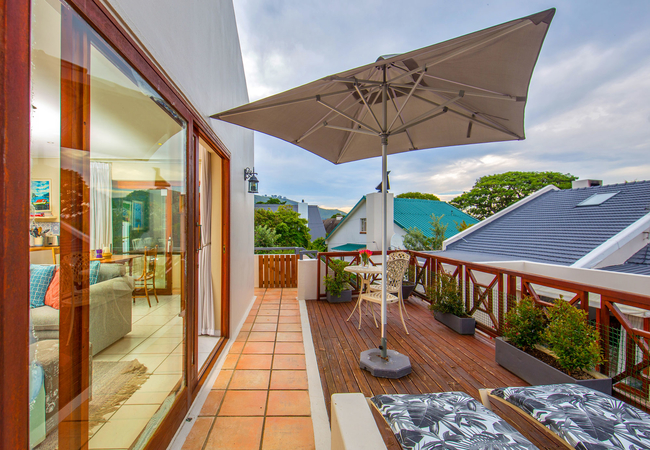
Founders Keepers
Founders Keepers provides the Garden Route visitor a unique holiday experience. Not only is our location superb, but it makes holidaying in Knysn...

Lagoon Terrace 17
Situated in central Knysna, Lagoon Terrace 17 offers accommodation in a comfortably furnished double-storey apartment which is ideal for a group ...
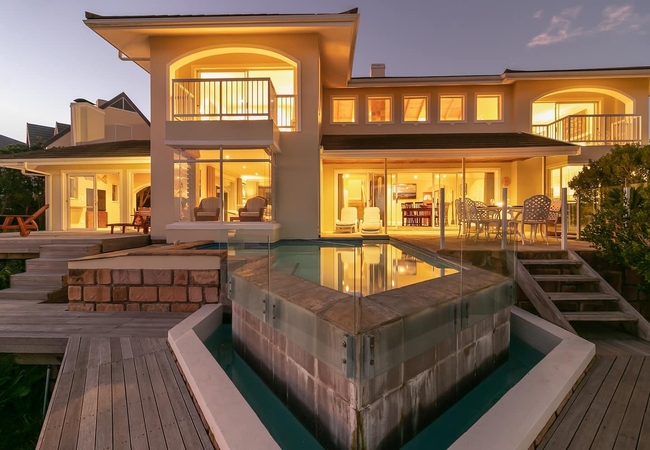
Ocean House
Ocean House is located in Pezula Golf Estate. This Knysna self catering villa enjoys wonderful views of the Indian Ocean and the prestigious awar...

P108 Plantation Manor
P108 Plantation Manor is a self catering holiday home in Thesen Island, Knysna. The house sleeps eight guests in four en-suite bedrooms. Two of t...

denBosch Cottages
Charlesford View offers four stylish and thoughtfully designed cottages which complement the surrounding landscape and seamlessly integrate luxur...
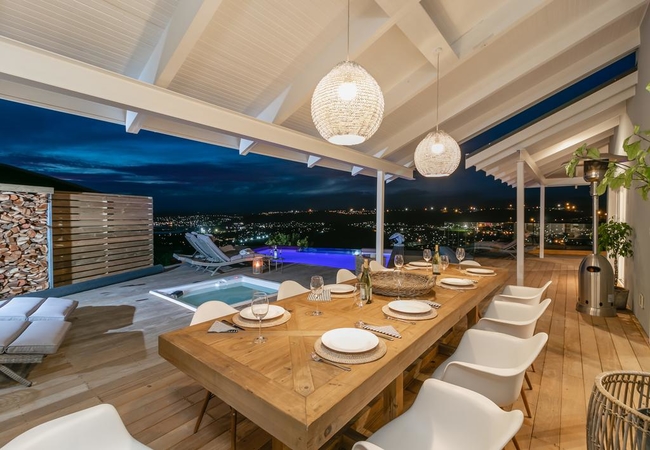
Pezula Heaven On Earth
Pezula Heaven On Earth is located in Knysna and is able to accommodate up to 10 guests on a self catering basis. There is a variety of attraction...

Sandy Feet Retreat
Sandy Feet Retreat offers Kynsna self catering in the heart of Leisure Island. The house has views to the right of the natural estuary as well as...

Forest Hills
Forest Hills is the perfect place for couples, families, and nature lovers to relax and unwind. We offer casual Knysna self catering accommodatio...

Earth Rose @ Forest Valley
Earth Rose @ Forest Valley is a beautiful cottage in Knysna. The bedroom is furnished with a Queen-size bed, dressed with quality linen. Sliding ...

Comfy Home on Thesen
The holiday home is thoughtfully designed to accommodate up to 6 guests, offering 2 well-appointed bedrooms and 2 modern bathrooms. The open-plan...

Moncrieff Manor
Boasting unrivalled views of Knysna, the lagoon and Knysna Heads, Moncrieff Manor invites you to forget the stresses of daily life and enjoy a br...

Pezula Ocean and Valley Views
Pezula Ocean and Valley Views is a modern spacious home boasting stunning uninterrupted valley and distant ocean views from its sunny Jacuzzi / e...

Pezula Heavenly Sunset
Pezula Heavenly Sunset boasts Knysna self catering in a holiday home offering absolute luxury and comfort for a family vacation or group of golfe...

Knysna Rose Cottage
Rose Cottage is situated in a secure, beautiful and tranquil garden where guests may enjoy observing the abundant bird-life or laze around the se...

Brenton On Sea Chalet
Brenton On Sea Chalet has three bedrooms. The living area leads onto a deck with outdoor furniture and braai facilities. The chalet also has a wo...

Villa Castollini
Villa Castollini, a remarkable guest house, is at first sight imposing and formal, but actually warm, hospitable and extremely friendly. Breatht...

Bergsig B&B
Bergsig B&B is situated near Pezula, Knysna and Simola Golf Courses. It is situated in a quiet area and has views over the lagoon and Outeniqua M...

Belvidere Manor Lagoonside Cottages
In the hamlet of Belvidere, close to Knysna overlooking the lagoon, lies the old manor house, Belvidere House, built by the founder of Belvidere,...

Golf Villa Knysna
Experience luxury at this exquisite four-bedroom holiday home, located in the renowned Pezula Golf Estate. Designed with both relaxation and ente...

Pumula Lodge
In the heart of the Garden Route, nestled between the quaint town of Knysna and the famous Knysna Heads, lies Pumula Lodge - "the place of rest"...

Number Eleven
Number Eleven sleeps up to eight guests in four bedrooms. All bedrooms have a King-size bed and an en-suite bathroom with a bath and a shower. Ou...
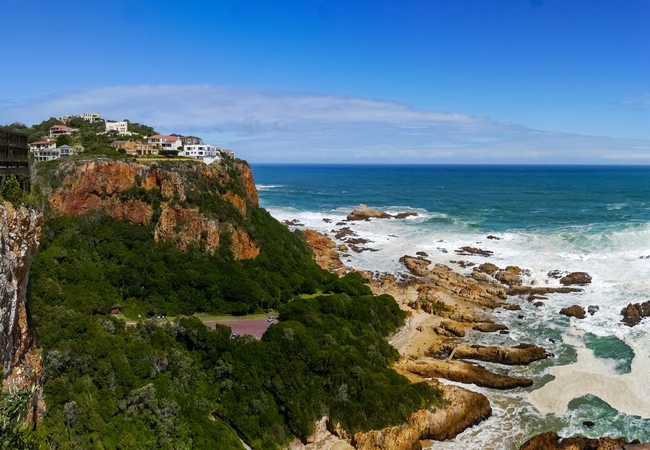
Villa Seaview
Perched at the very top of Knysna's Eastern Head, Villa Seaview is a glorious villa with fabulous views of the ocean from almost every room. Slee...

Premier Hotel Knysna
Situated on the edge of the Knysna Lagoon, Premier Hotel Knysna boasts a view of the beautiful indigenous forest. The area is serene and less tha...

Cliff Break
Cliff Break is an extraordinary luxury retreat perched atop a rugged cliff, offering uninterrupted views of the vast Atlantic Ocean. Designed wit...

Pezula Sunset Views
Pezula Sunset Views is a three bedroom holiday villa set along the ocean facing slopes of the Pezula Championship Golf Estate in Knysna, offering...

Peaceful Parkland Home
This spacious holiday home accommodates up to six guests, featuring three bedrooms and three bathrooms. Designed with an open-plan layout, the ho...

Glenview Heads Sea View Studio
Situated above the striking Knysna Heads, Glenview Heads Sea View Studio boasts accommodation with panoramic views from its wooden deck. Guests c...

Cearn Drive Seaside Cottage
Cearn Drive Seaside Cottage is a three bedroom cottage found in Leisure Isle in Knysna. Cearn Drive Seaside Cottage sleeps up to six guests in th...

Peace of Eden
Peace of Eden offers eco, vegan and vegetarian accommodation on the edge of the Knysna Forest. It is in the heart of the Garden Route, one of the...

Tides End Manor House
Tides End Manor House offers Knysna self catering accommodation for families or groups of friends wanting to enjoy all that Knysna and the Garden...

Brenton Haven Beachfront Resort
Perched high on a dune at Brenton-on-Sea main beach, Brenton Haven Beachfront Resort offers beautifully appointed accommodation in either 26 free...
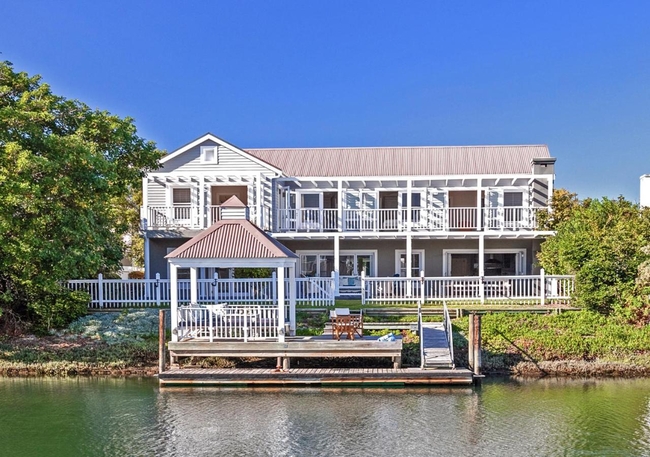
Perfect Canal Escape
Perfect Canal Escape is set along the picturesque canals of Thesen Island in Knysna, offering a spacious and elegant retreat for families to rela...

The Lofts Boutique Hotel
The Lofts Boutique Hotel is housed in the old Boatshed on Thesen Islands, Knysna. The refurbished building with its architectural design gives Th...

Leisure Escape
Immerse yourself in the enchanting charm of this three-bedroom, two-bathroom holiday haven on Leisure Island in Knysna. Nestled in the heart of S...
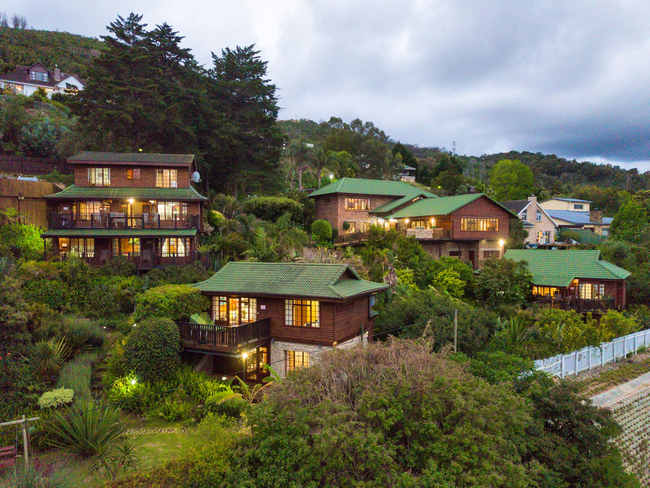
The Big Tree House Lodge
The Big Tree House Lodge offers unique self catering accommodation in Knysna. Our three timber framed units boast magnificent views over the Knys...
Beacon House
Beacon House is a contemporary luxury self-catering property located on the southern most property on the lower section of the Eastern Head. Thes...

At The Loerie
Situated in Knysna, At The Loerie is a historical house that was built as a hospital in 1883; the well worn doors and windows illustrate the many...

Pezula Sunny Tranquility
Pezula Sunny Tranquility is a beautifully presented home that offers classic Knysna self catering, a calm setting and a sunlit pool deck with a b...

Knysna N2 Lodge
Knysna N2 Lodge is situated on the corner of Main next to the N2 and offers affordable, comfortable, value for money accommodation. The Lodge off...

The School
The School is located in Rheenedal and offers comfortable guest accommodation. It is on an old school farm approximately 17km from central Knysna...

Pezula A Piece of Paradise
Pezula A Piece of Paradise is a holiday home in Pezula Golf Estate high above the picturesque town of Knysna. From here you are just a short 10 m...

Knysna River Club Getaways
Knysna River Club Getaways presents a selection of charming and luxurious chalets and apartments set within the exclusive Knysna River Club estat...

Isola Bella Guest House
This luxury villa is located on the water's edge of Leisure Isle with a commanding view of Knysna's spectacular lagoon. Step out of your front do...

TheBloem Guest Suites
TheBloem offers luxury accommodation in Knysna, in the Paradise area. Rooms are offered on a bed & breakfast basis and consist of a combined bedr...

Tshayile Holiday House
Tshayile House is a two bedroom self catering holiday house found in Leisure Isle in Knysna. The house features a large outdoor area and is one r...

Getaway On The Canals
Dry Mill T12 offers accommodation in Thesen Island on the canal, strategically placed next to the main canal on the island and is a short walk ac...

Knysna Manor House
Allow us the opportunity to spoil you by offering personal service at our 3 star, AA Highly Recommended Bed & Breakfast that is nestled in the he...

Paradise on Ridge
Paradise on Ridge is a holiday home in Knysna offering accommodation for six guests. The house has three bedrooms and two bathrooms. Two of the b...

Somervreug
Somervreug is an upmarket guesthouse situated in Knysna, the heart of the Garden Route. The accommodation has unobstructed views of the Knysna La...

Footprints of Knysna
The charming, owner run Footprints of Knysna offers three self catering units in a relaxed and peaceful environment. Enjoy your break with a stro...

Thesen Island Villa Q10
Located on Quill Island, this elegant villa offers an open-plan living space that seamlessly integrates a spacious dining area with a covered out...

Panzi Garden Suite
Located in Knysna, Panzi Garden Suite offers comfortable accommodation for up to two guests. From here you are near the the Knysna Elephant park ...

Narnia Country Guest House
On top of a hill 3km from the town of Knysna is Narnia Country Guest House, commanding views of the famous Knysna Heads, lagoon, river and Outeni...

Salt River Lodge
Situated on the northern side of the Knysna Lagoon, Salt River Lodge offers accommodation in a tranquil location. The accommodation is fully equi...

Palm Lodge
Palm Lodge is situated on a hill overlooking the Knysna Lagoon but only three minutes from Knysna town centre. Situated on a secluded property th...
Beacon House Apartment Four
Beacon House Apartment 4 is a self catering holiday apartment in Knysna, situated on the second floor, on the southern (sea) side of the building...

Knysna Belle Guest House
Imagine staying in a beautiful Cape-Cod style house on a small island (4km around) surrounded by calm Indian Ocean waters, just off a white-sand ...

Orange Inn Knysna
Orange Inn Knysna has a total of five bed and breakfast suites and two self catering apartments and can accommodate up to a maximum of fifteen gu...

6 On Protea
Situated high on a hill in the fittingly named suburb of 'Paradise', this luxury Knysna Bed and Breakfast offers its guests spectacular views of ...
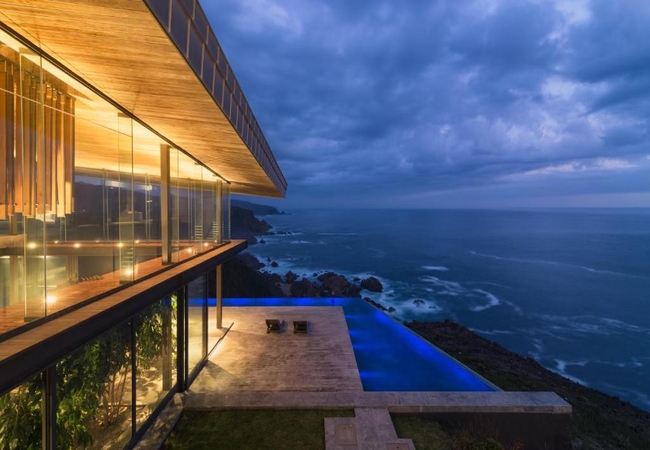
Pezula Heaven Can Wait
Pezula Heaven Can Wait offers accommodation in an ideal getaway destination. Lose yourself in the seamless views of the rugged coast while sippin...

Candlewood Lodge
Candlewood Lodge is situated in Knysna close to all amenities and 10 minutes from the nearest beach and other activities. When you just want to r...

Forest Edge
Experience tranquillity, romance and privacy in Nature at award winning self catering cottages. Nature-lovers' retreat: birds, game, secluded roc...

Brenton on the Rocks Guesthouse
Brenton on the Rocks offers accommodation on the cliffs of Brenton-on-Sea and boasts 180 degree views of the Indian Ocean. The Guest House has a...
Beacon House Apartment Three
Beacon House Apartment Three offers luxury self-catering accommodation in Knysna. It is an ideal location from which to base yourself as you expl...

Pincushion Heights
Discover Pincushion Heights in Knysna, a serene retreat with stunning 360 degree views of the lagoon, ocean, and mountains. The luxurious self-ca...

Pezula Franzi's Dream
Pezula Franzi's Dream offers luxury accommodation in the scenic town of Knysna along the celebrated Garden Route. It's an idyllic retreat for tho...

Ocean View Villa
Ocean View Villa is a single-storey self-catering house with views over the Indian Ocean, located in the secure Pezula Golf Estate in Knysna. The...

Villa Mulligan
Villa Mulligan is located on the Kanonkop hill, 2 kilometres from the town centre of idyllic Knysna. The spectacular view of the Lagoon, Knysna a...

Hawks Eyrie
Hawks Eyrie Holiday Home in Knysna has four bedrooms and four bathrooms. On the first floor or entrance level, is the main bedroom that opens ont...

Stannards Lodge
Discover a unique warmth and hospitality at this guest lodge, close to Golf courses and Lagoon in peaceful tranquil setting. Large manicured gard...

Elephant Rest Forest Cottage
Located on a farm in Rheenendal outside Knysna, Elephant Rest Forest Cottage offers self catering accommodation for six people. The timber cottag...

Gorgeous Olive
Gorgeous Olive is an open plan cottage in Knysna. Sliding doors lead out to a spacious deck with a table and chairs, a gas weber braai and a big ...
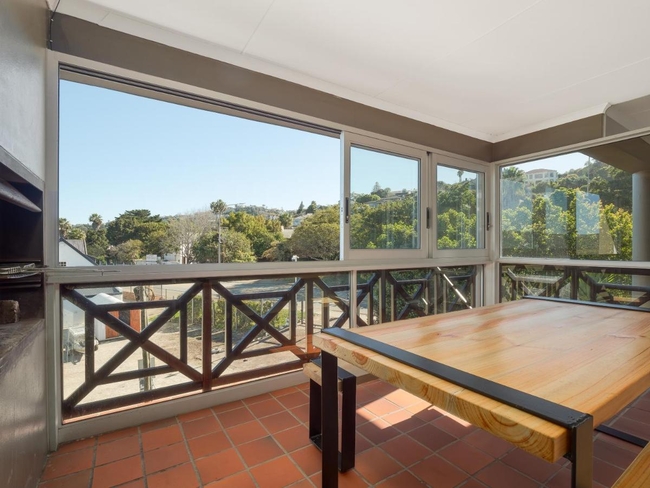
Summer Place Knysna
Designed to offer comfort and style, this family apartment provides a welcoming atmosphere from the moment you step inside. The accommodation inc...

Pezula Guccis Retreat
Offering self catering accommodation for eight guests, La Cascade is a modern holiday house located in the Pezula Golf Estate. The property boast...

Brenton Beach House
Brenton Beach House is a very pretty white Cape Cod style guest house in a quiet road overlooking the Indian Ocean, only a few minutes walk from ...
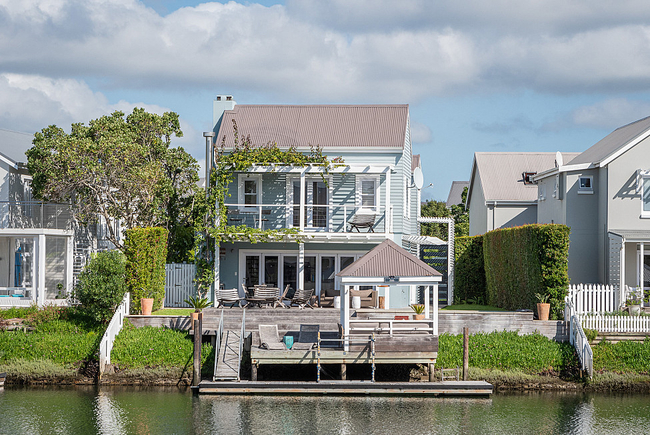

Glen House Self-Catering Units
Glen House offers four self catering units situated in the very exceptional part of Lake Brenton in a protected game area. Choose from four lovel...

Turbine Villa
Situated on Thesen Islands, this elegant three-bedroom villa offers an exceptional retreat for discerning guests. The villa features spacious, op...
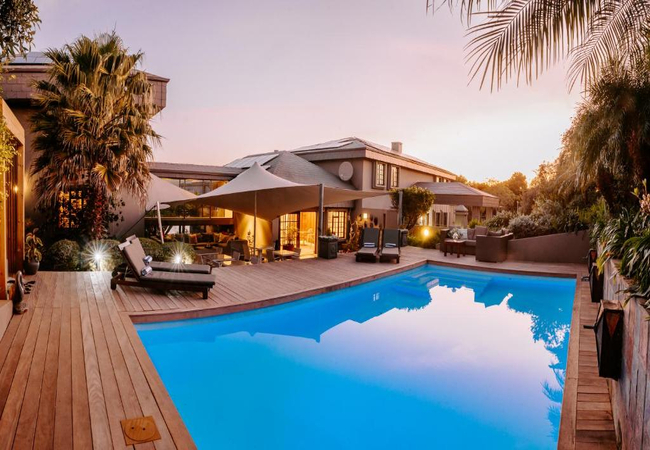
Kanonkop House
Indulgent comfort and gracious hospitality await you at the elegant Kanonkop Guest House in Knysna. Guests are offered golf membership at Fancour...

Canal Waterside Lifestyle
Koi Island K6 is warm and inviting offering accommodation in Thesen Island in an immaculate holiday home on the canals. Set in the heart of These...

110 Bay View
Bay View Guest Apartments offer a choice of self catering or bed & breakfast accommodation in affordable, fully equipped apartments and suites, a...

Fern Gully
Fern Gully is 18kms outside Knysna on the Rheenendal Road to the historical Millwood Goldmine and Jubilee Creek in a rural, forested area. The un...

Picturesque Retreat
This holiday home on Thesen Islands offers a tranquil escape in the heart of Knysna, situated along South Africa's renowned Garden Route. Ideal f...

Glory Dawn
Glory Dawn is an open plan holiday cottage in Knysna. Inside there is an enclosed Jacuzzi / spa bath with large windows where you can admire the ...
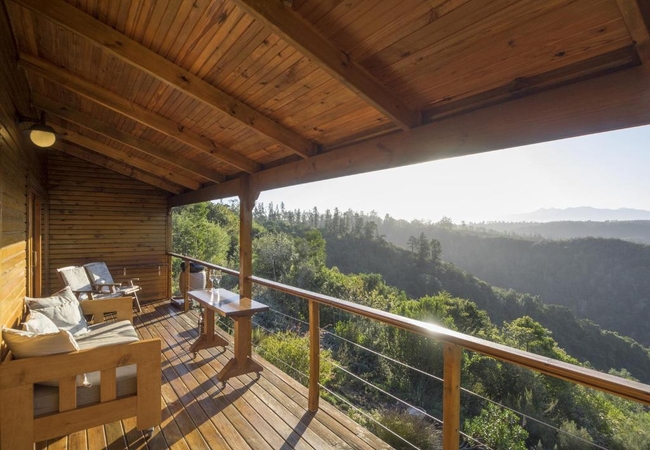
Cliffhanger Cottages
Cliffhanger Cottages are situated along the Rheenendal road and enjoy the peace of the unspoilt country, yet only a 15 minute scenic drive to the...

Knysna Log-Inn
This unique four star hotel offers fifty seven tastefully decorated rooms with all modern appointments. All rooms are air-conditioned, have flat ...

Timeless Canal Home
The property boasts 6 well-appointed bedrooms and 5 bathrooms, comfortably accommodating up to 14 guests. The open-plan living area provides a wa...
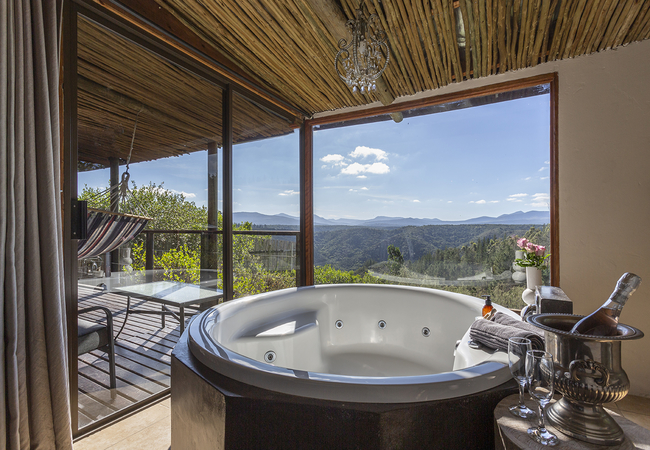
Forest Valley Cottages
Beaming with casual luxury.. Forest Valley embraces the dramatic beauty of the coastline town of Knysna with mountain and forest views. The offer...

Pezula Forecastle Retreat
Pezula Forecastle Retreat is located in Knysna and offers accommodation with splendid views of the area. From here you are close to many activiti...
Beacon House Penthouse Five
Beacon House Penthouse Five is a self catering holiday apartment in Knysna. This apartment is situated on the 3rd and 4th floors floor on the nor...

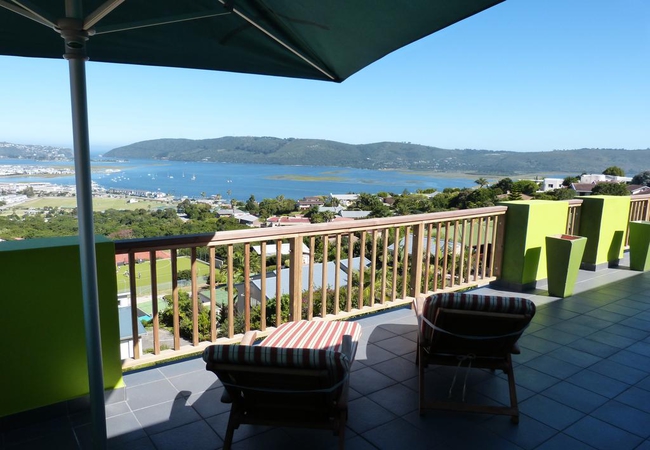
Knysnaviews Guest House
Knysnaviews Guest House is located on the hill above the centre of Knysna with breathtaking 180 degree panoramic views of the Lagoon, the famous ...

Pezula Luxury Retreat Forecastle
Pezula Luxury Retreat provides refined self-catering accommodation within the distinguished Pezula Golf Estate in Knysna. Guests enjoy full acces...

47th on Howard
Perfectly situated close to the Knysna Lagoon 47th on Howard offers luxury, style, service and location. Rooms overlook the marshland which teems...

Vibey Modern Apartment
Indulge in the perfect fusion of elegance and accommodation at this exquisite second-floor holiday apartment located in The Dry Mill on Thesen Is...

Guinea Fowl Lodge
On the banks of an enormous estuary lies Knysna, a town of extreme beauty. Our beautiful indigenous forests alongside Knysna are home to the only...
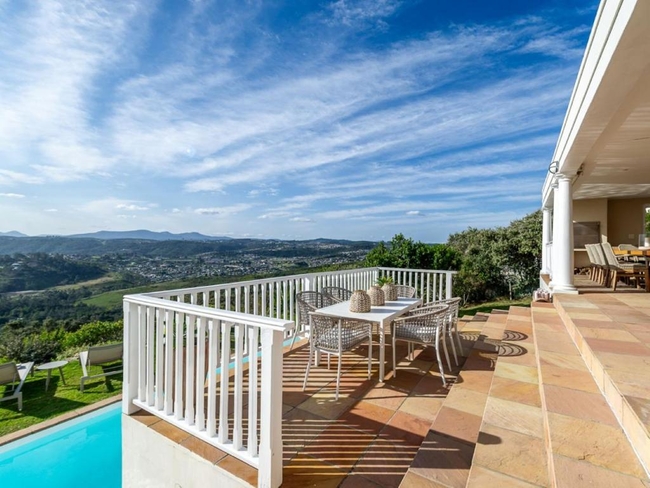
The Chandler
The Chandler is an elegant and expansive holiday residence situated within the prestigious Pezula Golf Estate in Knysna. Boasting sweeping views ...

Herons House
Heron House is a tranquil and spacious holiday accommodation located in the heart of the Knysna Lagoon, just a two-minute walk from the renowned ...

Fish Eagle Lodge
Well positioned with unique views of the Knysna Lagoon and mountains the Fish Eagle Lodge nestles against a ridge in a secluded country setting c...

Lavender Edge
Lavender Edge offers accommodation in Knysna for 4 guests with 180 degree views from the deck. Sliding doors lead out to a private deck with a ta...

The Light House
Situated a mere 10 minutes drive outside of Knysna, in a golf estate, The Light House is a holiday villa that accommodates up to 10 guests. Here ...

Knysna Pearl View Guest House
Accommodation at Pearl View is provided in six rooms, all of which are tastefully decorated and furnished with either a Queen-size or a King-size...

Sunnymeade Guest House
Sunnymeade Guest House embodies a family dream come true, gracefully situated in Heuwelkruin, Knysna, with sweeping views of the magnificent Knys...

Thesen Island Villa A22
Thesen Island Villa A22 is a sophisticated two-storey residence located at Heritage Bay Beach on Avocet Island, within the secure and highly rega...

Pezula Windstar Villa
Pezula Windstar Villa is a sophisticated 4-bedroom holiday home situated in the prestigious Pezula Golf Estate, offering an exceptional blend of ...

Paquita Villa
Paquita is a three bedroom self catering home located in right on the lagoon in Knysna. From here you have private access to the beach and can en...

Blue Sky @ Forest Valley
Blue Sky is a luxurious cottage in Knysna ideal for honyemooners or couples. The open plan cottage is air conditioned and is furnished with a Que...

Oyster Creek Holiday Home
Surrounded by the Knysna Lagoon with a spectacular view of The Heads, this intimate, luxury lodge can sleep up to twelve people on a self caterin...

Glenview Heads Gabriella
Offering accommodation in Knysna, Glenview Heads is situated above the Knysna Heads offering spectacular views from the wooden deck and the beach...

Overmeer Guest House
In this beautiful part of the Country, Overmeer Guest House is a luxury guest house where you can experience the peace and tranquility of the Gar...

Glenview Heads Studio One
Glenview Studio 1 is one of three apartments on the property, situated at Knysna Heads. The Knysna Heads are a pair of sandstone cliffs that sepa...

Simola Hotel, Country Club & Spa
The Simola Hotel is a five star hotel situated on the Jack Nicklaus golf course overlooking the magnificent Knysna Lagoon along South Africa's po...

bWhale Guest House
Situated along the beautiful Garden Route, bWhale Guest House in Knysna lies at the edge of a forest which has an abundance of bird life. Whether...
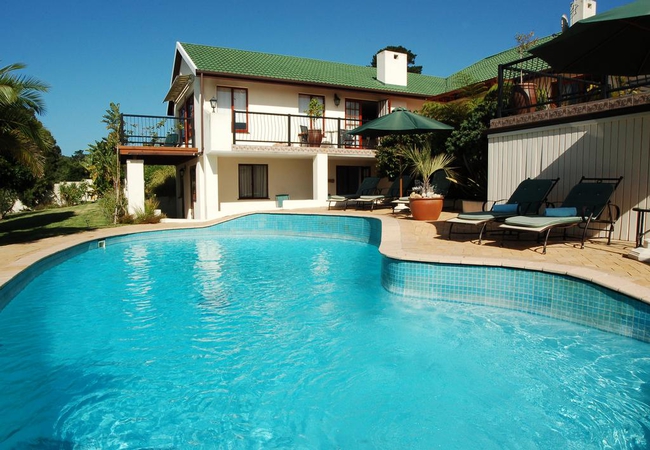
Knysna Country House
Knysna Country House is situated in the wooded suburb of Hunters Home, only minutes away from the Knysna and Pezula Golf Courses. The spacious an...

Lagoon Lodges
Comfortable accommodation in Knysna with lovely views of the Lagoon towards Knysna Heads. All units and rooms have a TV with DStv, Wi-Fi, an unst...

Sunny Dry Mill
Dry Mill T1 offers accommodation in Thesen Island, strategically placed next to the main canal on the island and is a short walk across the footb...
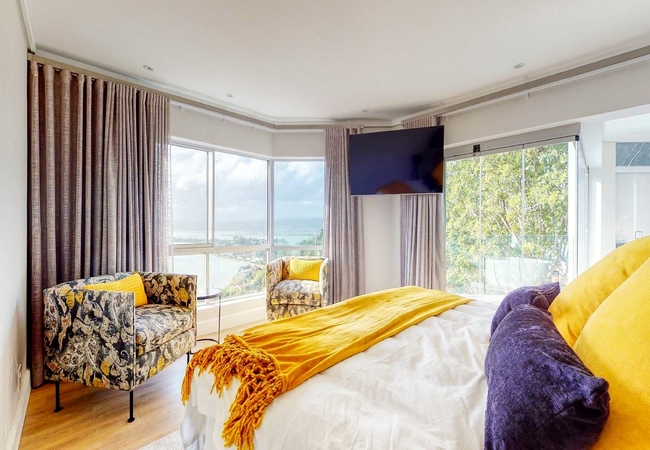
34 @ Paquita
34 @ Paquita is self catering holiday home located near the Knysna Heads. This holiday home is the ideal base from which to explore the garden ro...
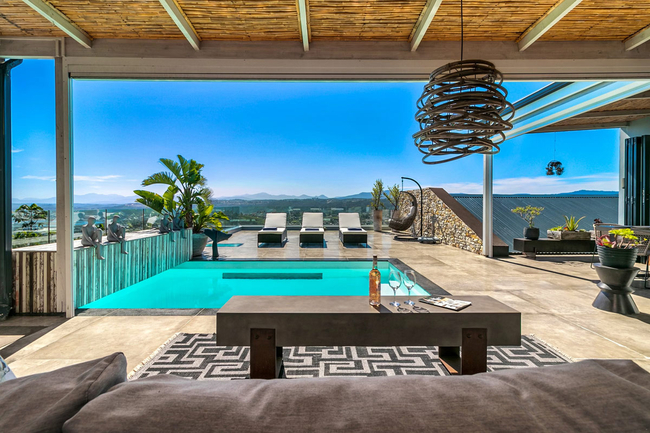
Pezula Birds Eye View
Designed to comfortably accommodate six guests, the villa features three well-appointed bedrooms and three bathrooms. The open-plan living area p...


The Baleia Guesthouse Knysna
Tucked within the quiet suburb of Heuwelkruin and just a short drive from Knysna’s lively town centre, this seven-bedroom retreat combines vintag...

Portland Manor
Portland Manor is nestled in the foothills of the Outeniqua Mountain range and just 20km from Knysna, offering accommodation in the perfect setti...

Woodlands Self Catering
Woodlands Self Catering is situated in Rheenendal and is able to accommodate up to 14 guests in five apartments. Here guests are near to attracti...

Pezula Extreme Elegance
This air-conditioned villa comfortably accommodates up to eight guests across four thoughtfully appointed bedrooms with three bathrooms. It is a ...

Island Villa
Island Villa offers accommodation in Knysna for large groups, large families and friends to get together and enjoy the pleasures of Leisure Islan...

Easy Canal Living
Crabclaw Island C32 is an ideal place to enjoy a relaxing holiday on Thesen Island in Knysna. The house sleeps six guests in three bedrooms. Two ...

Egret Cottage
Egret Cottage is a delightful three-bedroom holiday home located on the picturesque Leisure Island in Knysna. Guests can enjoy stunning views of ...

Alexander House
Perched high on the iconic Knysna Heads with sweeping vistas of the Indian Ocean, The Alexander embodies elegance, sophistication, and attentive ...
Beacon House Penthouse Six
Beacon House Penthouse Six is a self catering holiday apartment in Knysna. This apartment is situated on the 3rd and 4th floors floor on the sout...

Birdsong @ Forest Valley
Birdsong offers accommodation in Knysna boasting a Jacuzzi overlooking majestic views. Birdsong is perfect for lovebirds (sleeps two). There is a...

The Nest at Tshayile House
The Nest at Tshayile House provides accommodation for two guests in the quaint town of Knysna. Here guests are near to a variety of attractions a...
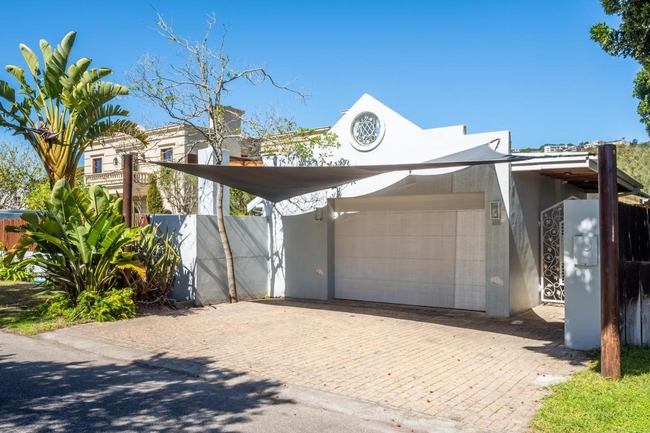
Pool House Villa
The Pool House on Leisure Isle offers a luxurious island retreat, where light and space converge to create a four-bedroom holiday home offering a...

Pezula Afternoon Delight
Pezula Afternoon Delight, situated in Knysna, is a luxurious holiday home that comfortably accommodates up to six guests. Its prime location offe...

Sandstone @ Forest Valley
Sandstone @ Forest Valley offers accommodation in Knysna with dramatic beauty. Enjoy cocooned seclusion and stunning views of deep indigenous for...

Amanzi Island Lodge
On the shores of the Knysna Lagoon you'll find Amanzi Island Lodge, a tranquil beach house on Leisure Isle, with spectacular views of the Knysna ...

Villa Paradisa Guest House
Villa Paradisa Guest House is a spectacular Guest House situated high up on Paradise hill in picturesque Knysna, the pearl of the Garden Route. E...

Pezula Maritime Luxury
Pezula Maritime Luxury offers Knysna self catering in a luxury holiday home, ideal for a family getaway or Golf weekend. The house overlooks the ...

Blackwaters River Lodge
A Getaway that offers abundant bird life, forest walks, canoeing on-site and time to relax and reflect either at the rivers edge or in the tranqu...
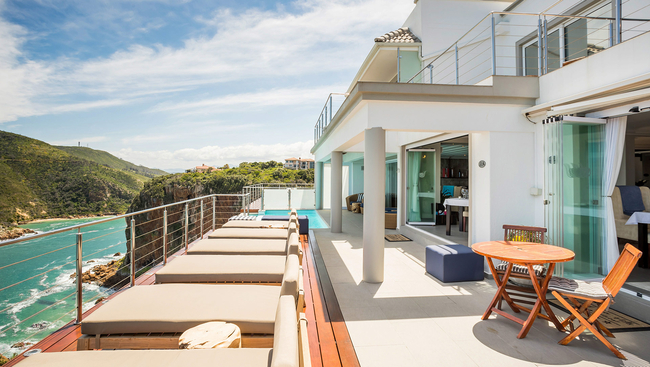
Head over Hills Luxury Retreat
Head over Hills is a boutique hotel situated on the edge of the famous Knysna Heads. Our luxury accommodation and world-class views are the perfe...
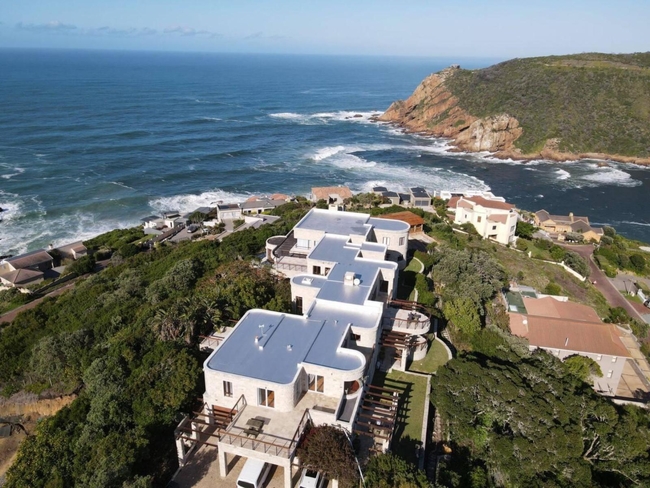
Castle On The Heads
Castle On The Heads is a beautiful Castle-Inspired Boutique Hotel-style property in Knysna where guests can enjoy panoramic ocean and lagoon view...

aha The Rex Hotel
Located on South Africa's picturesque Garden Route, aha The Rex Hotel is a celebration of urban style and impeccable service. This elegantly desi...

Pezula Luxury Villa
Pezula Luxury Villa offers self catering accommodation in Pezula Golf Estate, positioned in Knysna. Come and enjoy your next round of golf on one...

Wild Iris @ Forest Valley
Wild Iris @ Forest Valley offers accommodation in Knysna where you can enjoy cocooned seclusion and stunning views of deep indigenous forest vall...

Brenton on Sea Cottages
From the moment you arrive at Brenton on Sea Cottages you will be treated to the unspoilt surroundings, Brenton hospitality and thoughtful amenit...

Blue Fern of Knysna
Blue Fern Knysna offers comfortable bed & breakfast and self catering accommodation near the Knysna Lagoon. All rooms have a TV, Free Wi-Fi, tea...

The Russel Hotel
The Russel Hotel is centrally situated within walking distance of all Knysna's popular attractions. The hotel staff is friendly and always ready ...

Glenview Heads Miguel
The Knysna Heads are a pair of sandstone cliffs that separate the Knysna Lagoon from the sea beyond; the eastern head is easily accessible by car...

Cambalala Guest House
CambalalaGuest House is a luxury guest house ideally situated up in Paradise with magnificent views over the Lagoon - the perfect place to forget...

Lindsay Castle
Lindsay Castle offers accommodation in a large stone building built on rock at Noetzie, Knysna on the Garden Route. The property offers accommoda...

Yellowwood Lodge
Olde Worlde Victorian style, unique in its charm makes Yellowwood Lodge an must for the most discerning guest. The Lodge epitomizes gracious livi...

The St James of Knysna
The St. James of Knysna is an exclusive, owner run, five star country house hotel uniquely situated directly on the shores of the famous Knysna L...

Glenview Heads Studio Two
Glenview Studio 2 is one of three apartments on the property which is located at Knysna Heads. Knysna is part of the magnificently beautiful Gard...

Roseroc Boutique Guesthouse
This elegant home offers warm hospitality and truly breathtaking views of the Knysna Lagoon and Heads. It is nestled against a hillside in the le...

B My Guest Knysna Lodge
B My Guest is conveniently situated 2km from the town center and is walking distance to the lagoon walkway. This is the perfect spot from which t...

Issaquena Heights Boutique Hotel
Issaquena Heights boasts individually decorated suites offering luxury and comfort to all tastes. With the breathtaking view, a visitor never nee...

Pezula Wine & Sea
Pezula Wine and Sea Villa set within the prestigious Pezula Golf Estate in Knysna. This refined holiday home looks out toward the thirteenth hole...


Guadeloupe Self Catering
Guadeloupe Self Catering Cottages and apartments are centrally situated a mere 2.5 kms from the town centre, 2 fully equipped self catering cotta...
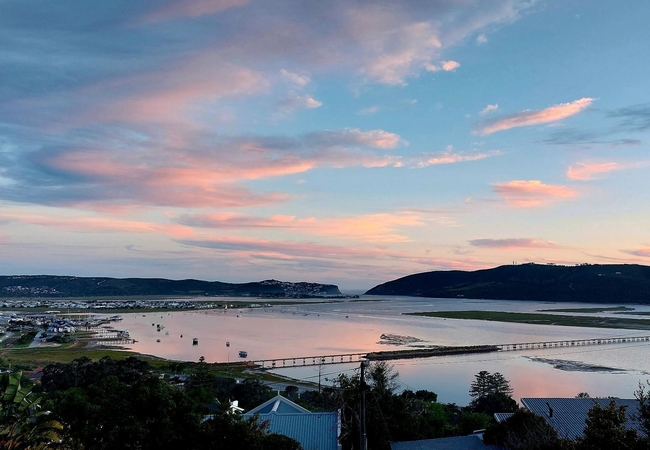
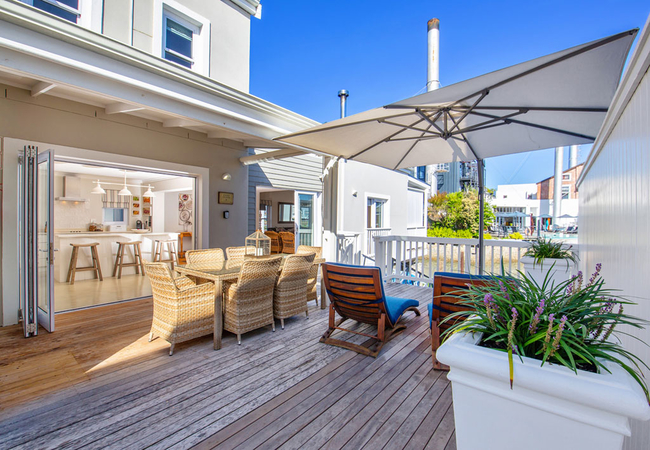
Thesen Island Holiday House
Thesen Island Holiday House which is located on one of South Africa's most exclusive destinations, Thesen Islands, on the Knysna Lagoon, in the G...

Lily Pond Cottage
Lily Pond Cottage is a place of tranquillity that can be found at Peace of Eden in Knysna. Whilst here, you can go for early morning walks meande...

Glenview Heads Apartment
Glenview Apartment is located in the popular Garden Route town of Knysna. The property situated above the Knysna Heads offers spectacular views f...

Fernhill Tented Treehouses
Fernhill Tented Treehouses offers unique and comfortable accommodation in safari-style tents with private decks and outdoor seating. Each unit ha...
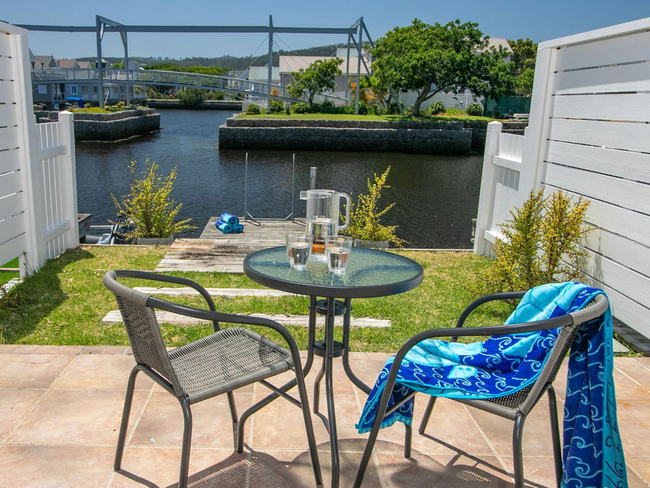
Elegant Entertainer on the Canal
Come and enjoy exclusive Knysna accommodation on the award winning Thesen Island development in the heart of South Africa's lovely Garden Route o...

Infinity Villa
Infinity Villa is perfectly positioned to maximize views stretching across the Knysna Lagoon, Heads Channel and far out into the Indian Ocean. In...

The Lookout 41
The Lookout is a holiday home in Thesen Island with five luxury en-suite bedrooms furnished with double beds. The fully equipped kitchen ensures ...

Double Dutch B&B
Double Dutch is a bed breakfast, guesthouse in Knysna with magnificent views over the Knysna lagoon at the Knysna Heads into the Indian Ocean. Ou...

Phoenix Lodge
Situated in the Paradise district of Knysna, Phoenix Lodge provides accommodation in a selection of rooms. Paradise is a great choice for travell...

Pezula House of the Rising Sun
Pezula House of the Rising Sun is a modern house located in the Pezula Golf Estate. This Knysna holiday home can accommodate up to eight people ...

Lagoon Serenity Retreat
Situated in the picturesque Leisure Isle district of Knysna, the four-bedroom Lagoon Serenity Retreat offers a tranquil escape for its guests. Ad...

Hudson Manor Entabeni
Hudson Manor Entabeni is a small working farm retreat on 35 hectares in the heart of Knysna providing bed and breakfast accommodation. This pictu...

Sheerline Close Luxury Home
Sheerline Close Luxury Home is situated on the Pezula Golf Estate in Knysna. This double storey luxury house is a self catering home offering acc...

Pezula Ocean Breeze Retreat
Pezula Ocean Breeze is an extraordinary cliffside villa, offering breathtaking views of the Indian Ocean and perfectly situated in Knysna. The vi...

Owl's Roost
Enjoy peace and tranquillity in the three star graded Owl's Roost Apartments suitable for three respectively two adults. Part of a private reside...

Harbour Town Apartment
Harbour Town Apartment offers Knysna self catering in the heart of the picturesque Thesen Island. From here you are just a stones throw away from...

The Garret at Tshayile House
Situated in the Garden Route, in Knysna, The Garret at Tshayile House offers comfortable accommodation for up to two guests. Here guests are near...

Under Milkwood Chalets
On the shores of the Knysna Lagoon, lies a village of timber log chalets amongst majestic Milkwood trees. This tranquil resort offers guests a ha...

Craighross Castle
Be king of the castle! At Craighross you can let your imagination soar as you rule over a mystical kingdom in one of the worlds most beautiful an...

The Mount Knysna Boutique Hotel
The Mount Knysna offers understated class in all its on-site facilities. Each of our suites has spectacular views of the Knysna Heads and all the...
Beacon House Apartment Two
Beacon House Apartment Two is a self catering holiday apartment in Knysna, situated on the first floor on the southern (sea) side of the building...
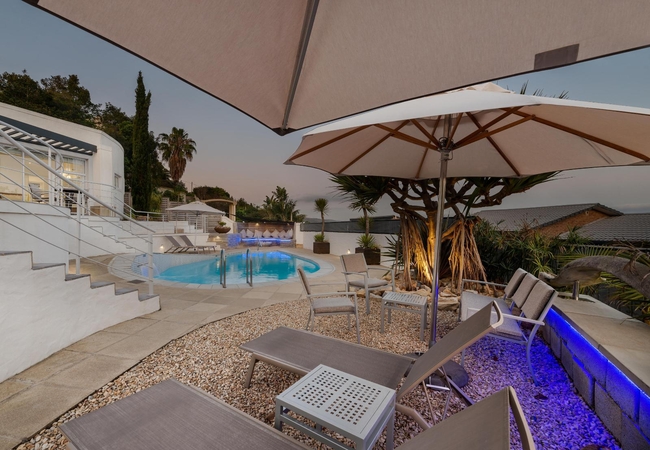
Villa Afrikana Guest Suites
Villa Afrikana is perched high above the town of Knysna, on a hill fittingly called "Paradise" overlooking the world renowned Knysna Heads and su...

Peaceful Holiday Retreat
Escape to your ideal holiday retreat on Leisure Isle, Knysna, in this charming family home featuring four bedrooms and three bathrooms, perfectly...

Amber Guest Lodge
Amber Guest Lodge is a four star luxury bed & breakfast Guest Lodge in Knysna, ideally situated between Knysna's two golf courses - Pezula and Kn...

One on Bollard
Situated just 10 steps from Bollard Beach in Knysna, this small bed and breakfast offers exclusive accommodation in four suites and a self cateri...

Cloud 9 Luxury Villa
Cloud 9 is an ideal location for a large family holiday or a special celebration. The Villa sleeps 18 guests in 9 bedrooms and offers beautiful 3...

Modern Canal Lifestyle
Experience unparalleled modern comfort at this 3-bedroom holiday home, positioned along the canals of Thesen Islands in Knysna. With spectacular ...

Serendipity Knysna
Serendipity Knysna offers comfortable accommodation in Knysna. The accommodation is perfect for couples or families and larger groups vacationing...
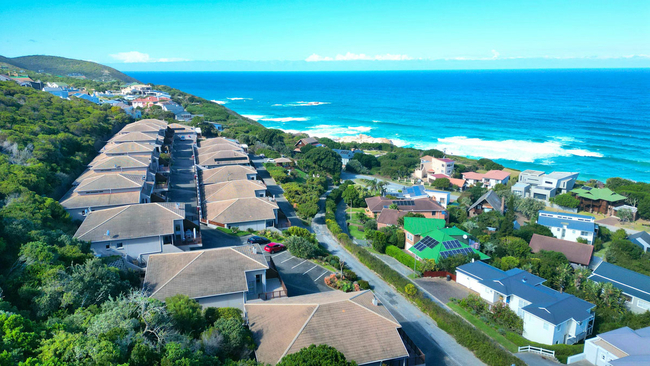
Waves & Whales
Waves & Whales luxury self-catering apartment sleeps up to 6 guests and features uninterrupted sea views from the main bedroom, lounge, and priva...
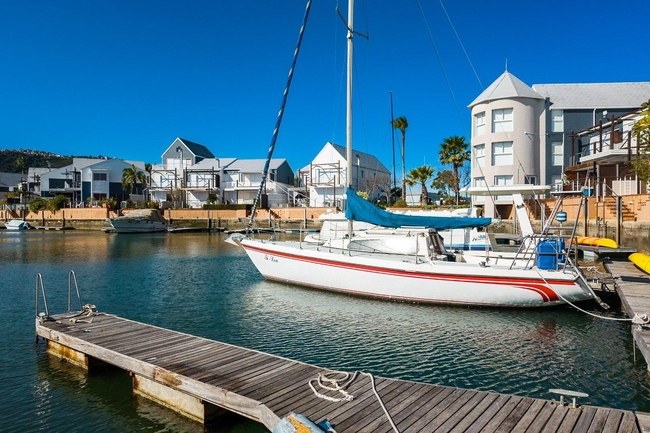
The Waterfront
Situated within the exclusive Quays complex in Knysna, The Waterfront is a three-bedroom home offering accommodation in a tranquil marina-front s...

Thesen Island Villa Q9
Thesen Island Villa Q9 is situated on Quill Island and offers three spacious bedrooms, a well-appointed kitchen with a scullery and laundry, and ...
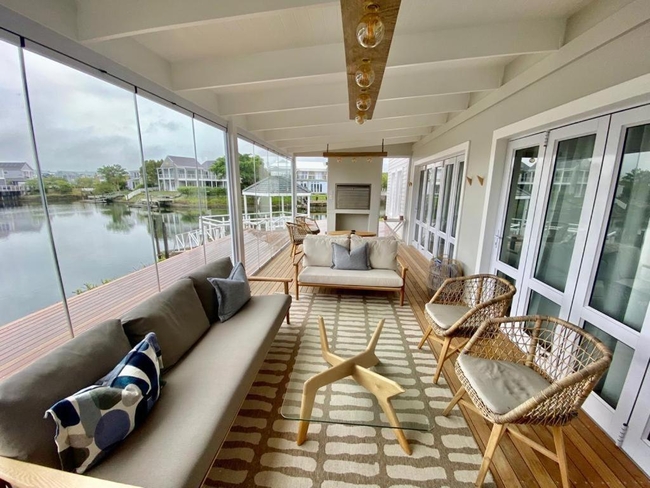
Thesen Island Villa H11
This sophisticated double-storey villa on Hammock Island presents 360 square metres of refined comfort, created with relaxation and style in mind...

Tranquil Haven
Tranquil Haven offers accommodation for six guests in the prestigious Paradise area of Knysna. Elevated above the town and surrounded by flourish...

Nyanza Knysna
Nyanza Knysna is a special and spacious self-catering holiday apartment in Knysna situated in a quiet crescent, within a minute's walk to the bea...

The Woodlands Nest
The Nest is a Holiday Cottage that sleeps two guests. The room is upstairs on a mezzanine level and is furnished with a Queen-size bed. There is ...

Elephant Hide of Knysna Guest Lodge
Situated on top of the Welbedacht Cliff Tops 3km from Knysna Town, the Lodge overlooks the Knysna Lagoon and the Outeniqua mountains. The lodge i...

Paradise Found
Paradise Found offers comfortable b&b or self catering Knysna accommodation with a heavenly view of the Lagoon and the Heads. Situated 2km from c...

Pezula Nature Retreat
Set in a paradise of ancient indigenous forests, mountains, lakes and pristine beaches on the well known Pezula Private Estate, Pezula Nature Ret...

Turbine Hotel & Spa
The Turbine Hotel and Spa is a boutique 5 star Hotel in Knysna which offers guests an extra special experience. This exceptional hotel in Knysna ...

The Greens Guest House
Offering Bed and Breakfast accommodation, The Greens Guest House has a swimming pool and views of the Knysna Heads and Knysna Golf Course. There ...

Brenton Breakers
Brenton Breakers offer self catering holiday chalets within walking distance of Brenton main beach. Six modern tastefully furnished self-catering...

Knysna Houseboats
Knysna Houseboats offers accommodation in well equipped houseboats, all outfitted to high specifications, for a truly comfortable experience. The...

Knysna Chalets
Knysna Chalets is found close to the town of Knysna, which is a great place for shopping and dining with a brewery, top-class restaurants and lot...
Things to do in the area

Knysna Scootours
Knysna is, undoubtedly, one of the most treasured gems of the Garden Route in the Western Cape. It is a seaside resort town that offers stunning ...

Ocean Sailing Charters
Discover the natural beauty of the magnificent Garden Route and Knysna on the largest and most luxurious Catamarans in the area.Enjoy an exhilara...

Day Sailing Charter with Springtide
Springtide Sailing Charters gives you the opportunity to take a turn at the helm of the 50 foot yacht, Outeniqua. You will be able to sail throug...

Drumming Experience - Find Your Rhythm
Find your rhythm to the beat of your own drum. Stomp your feet in 'rain boots' like a traditional African dancer and learn the Gumboot Dance. Cre...

Knysna Heads Oyster Experience
Learn a bit about Knysna from the water! The Knysna Heads Oyster Experience involves a cruise from Thesen Island Harbour and out over the main l...

Knysna Friday Market
Booking Knysna accommodation promises all sorts of exciting finds and gorgeous views. This is a Garden Route town full of promise and natural bea...

Lunar Cafe
Lunar Café is nestled within the ever-abuzz Knysna Mall in the centre of this small coastal town. Being situated along the world-renowned Garden ...

Accommodation convenient to Karatara Pass
FIND / South Africa Accommodation / Western Cape Accommodation / Garden Route Accommodation / Knysna Accommodation

